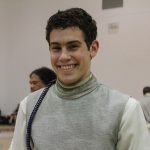 Gavin McGguire
Gavin McGguireHome Institution: Georgia Institute of Technology
Status: Sophomore, Expected Graduation Date: May 2020
Field of Study: Materials Science and Engineering with a Concentration in Structural/Functional Materials and a Minor in Japanese Language and Culture
Host Lab in Japan: Kyoto University – Dept. of Energy & Hydrocarbon Chemistry, Kageyama Laboratory
Host Professor: Prof. Hiroshi Kageyama
Research Abstract and Poster: The Effects of Structural Phase Transition on Photocatalytic Activity (PDF)
Why Nakatani RIES?
As the world gets smaller and smaller, it becomes more and more necessary to understand the ideas, cultures, and lifestyles of those unlike oneself. The Nakatani RIES Fellowship offers the perfect opportunity to pursue serious Materials Science research while experiencing the rich cultural centers of Japan. I have long been interested in Materials Science and Engineering (MSE), and collaborative research, let alone internationally collaborative research, is a fantastic venue for nurturing this passion. Of course, I also want to make sure that I further my Japanese language skills while abroad, and explore the idyllic nature settings I’ve yet only experienced second-hand. I am extremely excited to do research in Japan, and equally eager to be immersed in the centuries of natural and cultural history it has to offer!
Goals for the Summer
- Further my understanding and appreciation for Materials Science
- Apply past Japanese Language experience in real contexts
- Form meaningful relationships with my labmates and mentor
- Experience the Natural and Cultural heritages of Japan firsthand
Meaning of Nakatani RIES (Post-Program)
When I applied for the Nakatani RIES Program, I had a few broad goals in mind. I wanted to get a better idea of what graduate life truly is through a firsthand experience, and also wanted to explore new areas of Materials Engineering in order to find a particular field I enjoy. I am overjoyed to say that I achieved both of these goals in magnificent fashion. I really enjoyed my time in Prof. Kageyama’s lab, and could definitely see myself in a graduate lab either in Japan or the U.S. My research this summer centered on photocatalysts and optical materials, a field with which I had some prior experience at Georgia Tech. However, this summer research experience definitely cemented my love for this field, and I plan on pursuing it more and more in my future!
Research Internship Overview
During my time at the Kageyama laboratory, I investigated how the interaction of different crystal structures affect the efficiency of photocatalysts. I did this by synthesizing a variety of samples of PbZr(1-x)Tix with various ratios of Titanium to Zirconium. Once I created this spectrum and measured their photocatalytic activity, I found that at the phase boundary between the Rhombohedral and Tetragonal crystal phases, there was a large amplification of the photocatalytic activity. I absolutely loved working on this project, since the energy-technology and materials-chemistry divisions of MSE are where my passions have lain for quite a while. I learned a lot of great planning skills and of course how to operate some new equipment, and got a whole lot out of being in such a unique environment as an international laboratory. With more than two dozen researchers from six different countries, I had access to a wide variety of experiences and perspectives that I would be hard-pressed to find in the U.S. I know that I definitely want to pursue graduate school in my future, whether in the U.S. or abroad. I’ve found now that I’m comfortable in either setting, so I see no reason to limit my options!
The Kageyama group is without a doubt the most fun research group I’ve had the pleasure of working with. There is a wide age-range of students who are all very friendly and eager to get out and about, and I never once felt unwelcome in my lab. Everyone was treated as equals, regardless of degree program, age, or gender, and there is an overall air of collaboration and helpful courtesy all around. Professor Kageyama and Professor Cedric were both extremely supportive and helpful whenever I had questions or problems in my research, and I truly look forward to working or meeting with everyone again at some point.
Daily Life in Japan
I am without a doubt the luckiest person in the entire Nakatani RIES 2018 program. My apartment was located in Omiya, a major transit hub in Kyoto that had a massive bus terminal as well as a subway station less than five minutes’ walk from my apartment door! Location is without a doubt the most important factor when it comes to choosing a home, and I’m overjoyed to have been provided with such a great setup in that respect. Aside from that, I also rented a bike for the summer, which allowed me to get around when trains weren’t running, or to have some truly incredible picturesque moments along the shores of Kamogawa. Though it was difficult not being able to cook on more than a single induction burner, I still made plenty of food and found dozens of restaurants all over Kyoto prefecture that I’m sure I won’t forget for a long time. Overall, I was happy with how normal my life felt in Kyoto. Sure, there were moments of feeling like a tourist or foreigner, but I feel that even in Boston or New York when I visit family, or even sometimes in certain parts of Atlanta. There’s always more to discover in any city!
Experiences with Japanese Culture
Kyoto is known for being a city of culture and history. This shines through in everyday life, whether in the shrines and temples I pass every day on my walk to lab, the weekend kimono strolls, or the ancient buildings tucked away in the corners of bustling neighborhoods. There is a third unifying element of nature interspersed throughout the city, which is inevitable seeing as it is bordered on three sides by mountains and on two sides by rivers. Japan is a famously clean country, and Kyoto is certainly no exception. The profound respect that the citizens have towards their environment is extended to fellow citizens and even tourists, with nearly every social interaction I had in Japan leaving me with a smile on my face. The aesthetic, attitude, and overall essence of Japan is, in my experience, cooperation and mindfulness. Everyone is in the same city, the same country, the same planet, and there’s only so much time you’ve got between Shinto and Buddhist celebrations of life and death, so why waste time making relationships more complicated than they need to be?
- My favorite experience in Japan was… collecting Goshuin at the many Shinto Shrines across the country! I filled up my Goshuincho (Shrine Seal Book) throughout the summer, and it was a great way to track where I’ve been while getting to se some of the great cultural heritage that integrates so seamlessly into Japanese metropolises like Kyoto, Osaka, and Tokyo.
- Before I left for Japan I wish I had … Spent a bit more time doing ground-level research on my project. Although my project was changed the week before I arrived in Kyoto, I felt a little lost at times and thought that a bit more preparation, whether through classes or personal study, could’ve allowed me to make even more progress than I already did.
- While I was in Japan I wish I had…. Planned out my weekends a little bit better. Every day is precious, so sleeping in until 1:00 on a Saturday is the biggest mistake you can make during your Nakatani Experience! Make sure that you have some sort of plan in mind for free time, even if it’s just a general thought like “I’ll go to Kinkaku-ji” or “I’m gonna find a good sushi place tomorrow.”
Excerpts from Gavin’s Weekly Reports
- Week 01: Arrival in Japan
- Week 02: Language Learning & Trip to Mt. Fuji Lakes
- Week 03: Noticing Similarities, Noticing Differences
- Week 04: First Week at Research Lab
- Week 05: Cultural Analysis – Life in Japan
- Week 06: Cultural Analysis – In The Lab
- Week 07-08: Overview of Mid-Program Meeting & Research Host Lab Visit
- Week 09: Research in Japan vs. Research in the U.S.
- Week 10: Reflections on Japanese Language Learning
- Week 11: Interview with a Japanese Researcher
- Week 12 – 13: Final Week at Research Lab & Re-Entry Program
- Final Research Project Overview and Poster
- Follow-on Project
- Tips for Future Participants
Week 01: Arrival in Japan

Even before we arrived in Japan, I had some good times at Rice in Houston. Of course, the very first thing I did after unpacking at the hotel was go out for some Texas barbecue with friends! There’s no better way to bond with new friends than over food, and great barbecue is no exception. As for the actual orientation itself, there was certainly some sound advice to keep in mind. For instance, I had no idea that the trains stopped running after a certain time! As one of the alumni students recounted, this unfortunate fact of life in Japan can lead to spending the night napping in a pizza parlor far from home! For this and their many other tales of personal wisdom, I definitely thought that the alumni speakers we had at the pre-departure orientation were aa valuable asset to our preparedness and general “street-smarts” when traveling. Dr. Moran’s presentation on the poster advising was also very helpful, as we were able to pick out specific examples of what made a poster good even beyond the content itself. When the day finally came and we took off for Japan, I definitely felt confident that I could find my way around, culturally speaking.
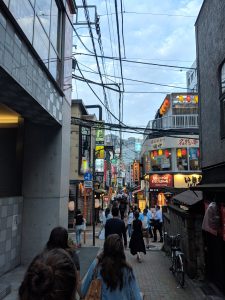
Despite having been in Japan for less than a week, I have had some truly incredible experiences already! During our first night out in Tokyo, the rain was coming down in sheets, and we made our way around a local shopping strip to a small soup shop for some refuge from the downpour- my idea of a perfect night! Since that first day, we have been fortunate enough to get the best weather that Tokyo has to offer, with blue skies and stiff breezes to spare. Tokyo itself reminds me a lot of New York City, but also of old Italian cities like Venice and Florence. While Tokyo certainly mirrors the urban sprawl and massive metropolitan population density of the former, the ease of walking and gold mines of cultural heritage simply can only be found in countries that are as old as Italy or Japan. However, these gold mines come with a price – I have found myself eating out quite often this past week, and while I certainly have a quest this summer to find a perfect bowl of tonkotsu ramen, I will need to budget my savings quite a bit more carefully if I want to make the most of my time here. In addition, navigation can be quite a challenge. I can usually keep my bearings in neighborhoods once I’ve lived there for a short while, but subway stations always disorient me- especially at nine at night in an unfamiliar neighborhood. However, I expect that once I’m settled in Kyoto next month I’ll know my neighborhood as if I grew up there!
As someone who has grown up regularly visiting New York City and now lives in Atlanta, easily the most striking difference that I have noticed in Japan is the public transport system. Not only has every single train, trolley, and bus been remarkably punctual, but everything has also been pristine, with only the odd gum wrapper to be found laying in a forgotten corner. This is definitively a reflection of the Japanese values of order and harmony, which dictate that every person has an obligation to their society to take care after themselves and be mindful of the others they interact with in their day-to-day life. While this idea is reflected hazily in America via the idea that “Many hands make light work,” the vast majority of people in America would much rather take care of themselves alone without a care for their surroundings, at least in my experience. This simply does not translate in Japan, where you must take care to dispose of your trash without public trash bins and stay nearly silent on the subway. Rather, I have learned to turn down my headphones, to keep a separate bag for trash, to look around me before “changing lanes” on the sidewalk. Whereas before in the States, I could just bob and weave through foot traffic in order to slip into class a moment before the bell, I find myself rather getting up earlier, taking my time enjoying the walks around our neighborhood, and arriving early for appointments. This is quite a welcome development, and I will definitely keep it up over the rest of the Summer and beyond!
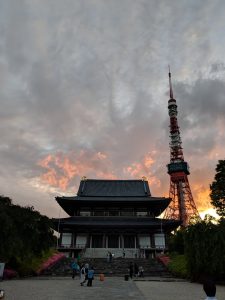
I have long abided by a simple motivational mantra- “There is nothing noble about being superior to your fellow man. True nobility comes from being superior to your past self” (Hemingway). I absolutely adore this sentiment and strive to it as much as I can in my daily life, from trying new things to lending an ear when needed by friends. To this effect, my main goal this year is to generally say “Yes” to unfamiliar experiences. For example, while it would be all too easy to find a McDonald’s or a Starbuck’s to rely on for breakfast or a quick meal, it would be a profound loss of valuable cultural experiences to do so! The same attitude prevails in how I view research. Though I have been fortunate enough to have worked in a Materials Engineering lab for the past few semesters, a full-time lab environment is certainly a new experience for me- and I making the absolute most I can out of it! Whether regarding a special seminar, extra training or certifications, or simply a night out to bond with lab-mates, I find it extremely important to take advantage of each and every opportunity presented to me.
Perhaps the most important skill to have when navigating new regions is knowing the local language. While I have studied Japanese for the past year and a half at Georgia Tech, our continued language classes every morning in Japan prove to be quite a useful tool for speaking practice. The occasional new grammar structure always helps open new doors conversationally as well! I always make an effort in shops and restaurants to order and check-out in Japanese as often as possible, since real-life practice is the best way to reinforce language learning. This past Sunday, I took this to a whole new level (for me, at least) when I shopped around a garage sale in Kamakura, Kanagawa! Aside from basic shop vocabulary, I was able to use some modest conversational skills in friendly chatter with the seller and other shoppers in the area.
Another interesting opportunity presented to us was having a guided tour of Tokyo University and some of the many labs within. Professor Tabata and his lab students were kind enough to give me and the other fellows a brief viewing of many interesting pieces of measurement and characterization instrumentation, which will surely prove useful for getting acclimated to the different labs each of us will be researching in for the rest of the summer. Though I will not be working with Professor Tabata this summer, I truly appreciate the time and effort he and his students set aside from their busy lives to give us a very useful experience.
Visiting the Earthquake and Safety Center in Ikebukuro was another great opportunity to get acclimated to Japanese life. Though I hope to never need to use any of the skills I was taught, such as safely escaping fires and navigating smoke-filled corridors, it is always better to be prepared! The earthquake simulator itself was definitely a new experience for me, since I have always lived in areas where earthquakes are exceptionally rare. For me, earthquakes have always been more of a concept than a concrete event that can actually occur. Of course, I had perspectives of movies, news reports, and other media, but being in the moment of an earthquake, even a simulated one, provided me with an entirely new frame of reference and a first-hand lens through which I can sympathize and relate to others.

Having played music in one way or another for the last sixteen or so years of my life, I was extremely excited to give Taiko a try! I loved the boundless energy of our instructor, and the choreography we were taught alongside the percussion itself was also quite fun to learn and try to master- though there’s only so much you can do in an afternoon lesson! I had always known that Taiko had origins in war-drumming, but seeing and hearing it first-hand introduces a profound emotional dimension to the experience at large. I really enjoyed this chance to learn about ancient Japanese customs and cultural practices. Another interesting cultural we enjoyed as a group was a guided visit to the various burial grounds and an archaeological museum in Takasaki. While much of the burial grounds are still shrouded in mystery, we were able to learn quite a bit of what feudal Japanese manors and burial grounds could’ve looked like hundreds of years ago. In the process, much was also revealed regarding social structures and some local traditions and rituals at each of the burial sites we visited. One such ritual is a physical contest which later evolved into the modern sumo we know today.
Ogawa-san’s presentation on the history of Sumo was extremely interesting! I never knew that it originated as a sort of agricultural ritual, which gives me a whole new perspective on the values of the Japanese people of old. I’m definitely looking forward to going to the Grand Tournament this upcoming week!
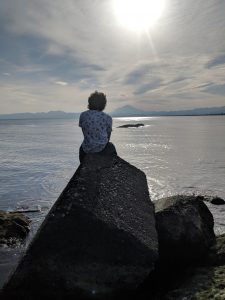
Finally, on my first full Sunday in Japan, I took a trip down south a ways with Kaitlyn, one of the other Nakatani Fellows. We took a series of trains first into Kamakura, then later into Enoshima. Not only was all of the nature stunningly beautiful, but we also got to visit quite a few Shinto Shrines and Buddhist Temples. Seeing as that I have long loved the nature and spiritual scenes of Japan, this was a perfect day for me! I also got a Goshuincho, which is an accordion-style book with plenty of pages on the inside for receiving Goshuin, which are the seals of various temples and shrines across Japan. Each one is unique and they are symbols of one’s pilgrimage to that particular location, so they carry quite a bit of spiritual weight. I hope to fill up my Gosshuincho as much as I can throughout the regions I visit in Japan! Also in Kamakura, we took our time getting lost and enjoying a few detours along the roads we walked, ultimately making it all the way to the Enoshima Cave System on the southern tip of the island. As we started the long walk back to the train station to get us back into Tokyo, we stopped and saw Mount Fuji in all its glory all the way across the Sagami Gulf next to the setting sun. I can’t wait to see what else I can explore in Japan this Summer!
Research Host Lab Overview
This summer, I will be working under Prof. Hiroshi Kageyama at Kyoto University. As a student with a particular interest in Materials Chemistry and energy technology, I was ecstatic to see that my research would be on visible-light photocatalysts for reactions like water splitting! Currently, almost all known photocatalysts for these reactions are semiconductors, but it is believed that some mixed-anion metallic oxides would show some very interesting and unique properties. I will be synthesizing, characterizing, and observing these materials throughout the course of the summer.
Prior to my arrival at Kyoto University, Prof. Kageyama had sent me a paper that he and his lab had published earlier this year. In the paper, entitled “Expanding Frontiers in Materials Chemistry and Physics with Multiple Anions,” the Kageyama Lab reviews various methods and properties of inorganic oxide compounds, a class of materials that have been in use since primal arrowheads and axes. Of course, our modern applications of these materials is much more sophisticated, such as in applications in pigments, Lithium-Ion batteries, and photocatalysts. On the atomic level, there are a great many parameters that can be altered in order to tweak the properties of the resultant mixed-anion material. For example, by replacing one of the Oxygen atoms in a classical atomic octahedron, it is possible to generate a degree of local asymmetry which can produce exotic optical and chemical properties. A particularly interesting concept is replacing one or more anions in a host molecule with a different anionic molecule, giving rise to anisotropic shape and bonding, or even an exploitable magnetic moment with some particular anions. Mixed-anion oxides can also undergo variations in processing parameters in order to produce a uniquely-applicable compound. In particular, the atmosphere of synthesis can be varied in terms of composition and flow rate in order to obtain novel permutations of previous materials.
Week 02: Language Learning and Trip to Mt. Fuji Lakes
Orientation Program in Tokyo: Week Two Overview
I’ve had a good amount of success using Japanese in my day-to-day life. I scheduled a doctor’s appointment in Japanese and use it whenever I buy food or run other errands. While I haven’t had any overzealous native speakers rushing up to me in stores complimenting a foreigner’s language skills, (I’ve still a long way to go!) I certainly feel my own sense of self-esteem boosted whenever I have a successful interaction with a store clerk or fellow shopper. I also got to use my language skills a bit with the Japanese Nakatani RIES Fellows when we all got together this past weekend!
During the week, we continued our cultural orientation. One particular seminar was Prof. Shimuzu-Guthrie’s lecture on the cultural history of baseball between the US and Japan. Despite having only a cursory knowledge of basic baseball facts and history, I still could appreciate a lot of the historical and cultural context that was explained to us. While I have long known that baseball is quite a popular pastime in both the US and Japan, I didn’t know that it was brought over by Civil War veterans, or that it played such a large role in post-WWII relations between the nations. On the US side of the story, the story of the Philadelphia Bobbies was especially interesting to me. This all-women baseball team travelled around Japan, China, and Korea in 1925, playing many exhibition games and, to quote Prof. Shimuzu, “Absolutely beating the tar out of them.” Baseball played a much greater role in representation of each culture in the other’s nation, and both Japan and the US were able to grow stronger friends because of it.
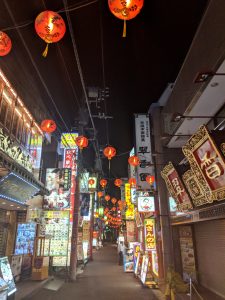
After having the seminar on how to build the best possible supercomputer last week, it was a real treat to be able to go to JAMSTEC and get a first-hand perspective on their operations! I really enjoy Earth and Marine Sciences, so touring the Yokohama facilities and seeing the techniques and technologies behind JAMSTEC’s contributions to the scientific world was an incredible opportunity for me. I really enjoyed seeing all the features of Chikyu, the flagship of JAMSET’s fleet, which boasts a massive drilling tower to excavate deep-sea sediment samples. JAMSTEC also does a lot of public-access photography, which I could appreciate first-hand when later in the week, I noticed the JAMSTEC logo next to some deep-sea photos at the aquarium! Touring the supercomputer facility itself was also very interesting, although we weren’t able to go into the heart of the facility with all of the computer banks. After the facility visit, we all went out to Yokohama’s Chinatown for dinner at a buffet-style restaurant. Food is an integral part of any cultural experience, and I’m very grateful that we were able to share such a meal as a large group.
One of the other interesting outings of this week was our trip to the Edo-Tokyo Museum and the Grand Sumo Tournament. Though I had seen brief clips of Sumo in television and the internet before, seeing the bouts live was a new experience entirely. There were a lot of rules to figure out on the fly, but by the end of the evening we were all cheering along with the rest of the crowd! I’d love to go to another tournament sometime. Just before the tournament, we travelled to the Edo-Tokyo Museum. I really enjoyed seeing all of the reconstructions of Edo-era cities and manors, and it really struck me how similar the general structure was to the early civilizations I had learned about in Africa, South America, and the Middle East. However, I was most appreciative of the modern Tokyo portion of the museum. There is a certain national bias inherent in any history lesson, regardless of country, and sometimes facts can be bent and represented in such a way that doesn’t quite give the whole story. This is exactly why this trip to the museum was so important – just a few exhibits and alternate accounts of the same event can drastically change one’s perspective on an event, and it is always important to get as many sides to a story as possible. By getting to see the Japanese perspective of the 1940s, I learned some new facts and figures that I certainly hadn’t heard in history class back home, or even seen in some museums. I was also very interested in seeing exactly how Japan developed from 1945 to the present, especially how it became such a thriving technological center! I look forward to exploring even more old Japanese culture upon my arrival in Kyoto in June!
Mt. Fuji Lakes Trip with Japanese Fellows
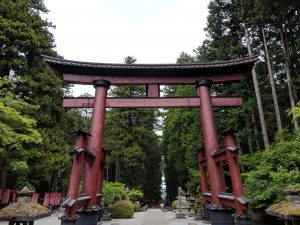
As with any new group, we all were a little slow to intermingle with the 2018 Japanese Fellows, but nothing breaks the ice quite like food! By the time lunch finished around the Kitaguchi Hongu Fuji Sengen Jinja, we were laughing and joking like good friends. Speaking of the shrine, it itself was very striking to me. The biggest thing that stood out to me, both in memory and physically, was the massive Tori gate standing near its entrance. Tori are at the entrance to Shinto shrines and demarcate the passageway onto the shrine grounds. However, the massive Tori is not for the shrine where it stands, but rather for Mount Fuji itself! The shrine is dedicated to the mountain and those who climb it, and there is a footpath that starts at the shrine that goes all the way to the summit. When describing my plan to follow this path all the way up the mountain to my brother, I described it as “The best bad idea I’ve ever had.” I only hope that my research schedule at the end of the summer allows me to follow through with this plan.
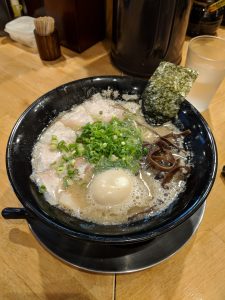
In the meantime, I’d have to settle for taking a bus up to the fifth station of Mount Fuji with the group! We had a good time looking out around the slightly cloudy view and perusing the many souvenir shops and snack stalls. Tired and hungry, we took our bus to the Gotemba Kogen Resort, where we would share our rooms with the Japanese Fellows. As we set up our Hobbit-home rooms, we continued our joking and laughing before heading off to yet another all-you-can-eat buffet for dinner. Following dinner, we enjoyed a Disney-esque water and light show. We headed to the Onsen to relax, and as we went around our circle telling stories about ourselves, I felt like I had known everyone all my life! The next day, we began our trip back to Tokyo, with a few fun detours along the way.
First, we stopped off at a restaurant near the Numazu Deep Sea Aquarium to have some amazingly fresh seafood, then walked around some street markets. Katsuya, one of the Japanese fellows, added me in Facebook and we’re planning on meeting up in Kyoto if we can! Following lunch, we travelled to the Mishima Skywalk, which is the longest pedestrian bridge in Japan! It was really interesting discussing the possibilities of how it was built with the other fellows. Our final detour took us to an all-you-can-pick strawberry farm, where we enjoyed fresh strawberries with sweetened condensed milk- a local specialty! Though I haven’t liked strawberries very much, I certainly ate my fill and would love to go back sometime!
I really enjoyed spending time with the Japanese fellows, as each one brought an interesting personality along with them to make everything more fun. They were also very eager to help us with our Japanese as we helped them with their English, reinforcing the idea that everyone in this program is here to make themselves and those around them better people. They were all very polite and kind at meals and extremely enjoyable to be around when sightseeing and in the resort! I hope that I can continue all of the new friendships that have started this weekend.
Introduction to Science Seminar
Professor Kono’s introductory lectures were extremely helpful for me. I haven’t taken quite as many high-level physics classes as some of the other Fellows, so having a valuable resource like Professor Kono was quite an asset prior to leaving for my lab. Professor Otsuji and Professor Saito also provided me with some new background knowledge regarding carbon nanotubes and other nanostructures that, while not directly correlated to my research, was certainly very interesting and will help me to better understand the work of my colleagues this summer! Though I had some lingering questions after the first and second seminars, I was able to clear them up through discussion with my peers and a quick consultation with Google-Sensei.
Conversely, Professor Kono had a few questions for us about our research, regarding the properties and inherent character of our materials that we would be working with this summer. Personally, I will be working with mixed-anion metal oxide compounds. Metal oxides have been in use by humans for millennia in ancient arrowheads and axes, but more recently we’ve upgraded quite a bit to chemical catalysts and electric sensors. However, by adding in other anionic species, whether they be simple atoms or complex molecules, entirely new and exotic properties will probably arise. The structures of the compounds themselves are extremely versatile, and as such can be manufactured into 0D catalysts, 1D polymerized chains, 2D plates of material, or 3D structures known as Perovskites. Since I will be focusing primarily on water-splitting reactions, I will mainly be studying the chemical catalytic properties of 0D metal oxides. Though I do not yet know the specifics of my day-to-day lab procedure, I do know that I will be synthesizing the materials that I will later characterize experimentally. Though my focus is on catalysis of water splitting, this class of materials is also useful in photovoltaic cells and thermo-electric applications. These materials are quite cutting edge, so the best way to find out their best applications is to characterize them in lab and then choose a venue that suits them best!
Question of the Week
How does the live music scene differ from one city to the next? Do different cities and prefectures have distinct styles of music?
- See the section on Music in Japan on our Life in Japan resources page for more on this topic.
Week 03: Noticing Similarities, Noticing Differences
Over the last three weeks, I have noticed two fairly innocuous things that struck me as prime examples of Japanese culture in action.
Firstly, every day at exactly 5:00 PM, a melody floats over the neighborhood, signaling the end of the workday. It is a different melody depending on where in Tokyo you are, and sometimes individual stores themselves have a unique melody. This fits extremely well into the “form” and “harmony” aspects of Japanese culture, as it is a very old-fashioned way of making sure that everyone knows when to go home- even if current work culture has made the 5:00 end tie more of a suggestion than a rule.
Secondly, as I am reminded every morning, the alarm clocks have no snooze button. Whether this is simply the model that our hotel room provides us or an overarching concept of Japanese life, it is certainly indicative of the trademark punctuality that is found everywhere you look in Japanese life. Here, when you set an alarm, you expect yourself to adhere to that deadline; disabling a wake-up call simply defeats the purpose of the alarm itself.
Of course, another place where this punctuality defines Japanese life is the public transportation system. I am fortunate enough to have become very familiar with the subways, buses, streetcars, and general rail system in Tokyo, and in the process, I’ve noticed a few behavioral quirks of the other riders. While people prefer to sit whenever they can, people are more likely to wait for the train to start to crowd up before they take the dreaded seat next to another person! However, during the rush hours, all bets are off- cram in as many as you can into a car and hope you can find your way through the mass once you arrive at your station.
When taking particularly long rides, I see many people reading books, playing phone games, or even passing the time on a couple of handheld game consoles. However, I’ve never once seen loud music leaking out of dangling headphones, or a noisy commuter on their phone. I only wish New York and Atlanta’s metro systems were the same way! They are generally a bit dirtier, and I’ve never once taken a public bus in the U.S. because I value my life over an extra three-dollar fare or a bit of a walk. In addition, of course, American commuters are much more boisterous and prone to spilling their share of sound all along the railcars.
These differences are clearly reflected in the traditional Japanese values discussed in the pre-departure orientation, especially with regards to mindfulness and harmony. While Japanese commuters tend to be more considerate and look after other, Americans are decidedly less harmonious and mindful. However, in tune with American friendliness and hospitality, we’re no strangers to picking a seat next to a stranger or making do with someone else’s music choices.
Orientation Program in Tokyo: Week Three Overview
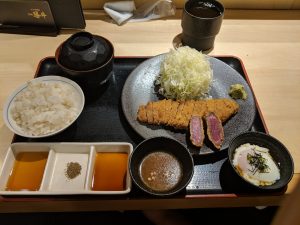
This week, I had plenty of experience taking the metro lines around Tokyo, since we had quite a bit more free time than in the previous weeks. On Monday, I went with a few other fellows to Ueno Park and the National Museum, only to find out that it is closed on Mondays. Rather than loathing our loss, we instead walked around Ueno, finding the never-ending flame of Hiroshima as well as a magnificent display of Bonsai trees in Ueno Park! Our afternoon saved, we returned to the hotel with plenty of pictures, and in my case, a few more Goshuin in my book!
On Wednesday and Thursday, I had a bit more transportation experience when I popped over to Ikebukuro to pick up some omiyage (souvenirs) for my brother and friends. I also went to Ochanomizu to get a particular souvenir for myself, a decent ukulele to keep up my musical efforts while in my apartment in Kyoto! While it is a fairly modest instrument, I look forward to de-rusting my ukulele skills and adding another instrument to my makeshift apartment studio!
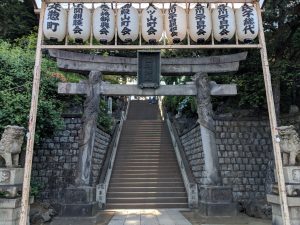
With the end of language class this past Friday, I had a bit of time to reflect on how my language skills have developed in the past three weeks. While I do wish we had progressed a bit more in terms of grammar practice, I certainly have gained quite a bit more smoothness and intuition in my speaking and conversational skills. I recognize that I could do with more practice in reading a speech aloud from a prepared script, but I am much more confident in my improvisation skills. Using my language skills with the Nakatani Fellows during the Mt. Fuji trip was very rewarding, and I look forward to conversing with my lab-mates this summer!
Ito-Sensei’s talk about the cultural significance of the Kimono was extremely enjoyable. I really appreciated how he went around the room and took individual questions from each of us, and it was incredible seeing the widely varied life he has enjoyed for the last few years in his travels throughout Africa, Asia, and Europe. I had no idea how popular the kimono used to be until a handful of decades ago and was very impressed by the multitude of beautiful designs that he and his colleagues had come up with for the Tokyo Olympics – I really hope to see them worn at the opening ceremony in 2020! One of the ideas presented that stuck with me was the culmination of the section regarding the Tea Ceremony. This part of Japanese life is well-known for being painstakingly deliberate and precise, shrouded by a great cloud of tradition as well. However, Ito-sensei recounted some simple but profound advice regarding the actual practice itself- “Just make some tea.” While this seems as simple as “Just draw the rest of the owl,” it really means that you must focus entirely on one thing in order to do it well and free your mind of other incidental distractions. When you “Just make some tea,” you’re doing just that, and nothing else. This ultimate dedication to the craft and hospitality is one of the essential tenets of Japanese culture.
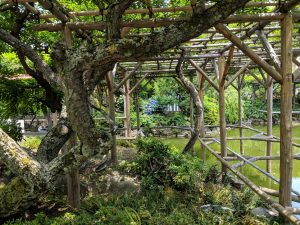
Finally, Ozaki-Sensei returned to gift us some parting words of wisdom regarding social behavior, especially some helpful omiyage tips! While I was reassured by the fact that I already knew some of what Ozaki-Sensei told us, I certainly learned a few novel phrases and “jokes” that I’m sure will come in handy when giving gifts and meeting new people. There is only so much you can learn from textbooks, and as such having a resource like Ozaki-sensei to give us practical background in social situations.
On my last day in Tokyo, I had two goals: visit as many shrines as possible, and find my ultimate Japanese souvenir, a Shamisen. I am extremely happy to say that I was successful in both of these pursuits and am looking forward to learning this exciting new instrument during my time in Kyoto and beyond! I rounded off the day by stopping off at my favorite ramen shop by the hotel, called Hakata Ichiroi, for one last incredible bowl of Tonkotsu Ramen. I’m sure I’ll find another great place by my apartment in Kyoto- I think there’s a place on the same block as my apartment! As much as I loved living in Tokyo, I am very excited to move to Kyoto and settle into a more permanent lifestyle. I can’t wait to see what else lies in store for me in the rest of my summer!
Introduction to Science Seminars
We had a few more speakers come in this week to teach us more about nano-engineering, particularly carbon nanotube (CNT) activity and Terahertz-region spectroscopy and characterization of semiconducting materials. The first of these speakers was Prof. Chris Stanton from the University of Florida. Prof. Stanton provided a new spin on the electronic properties discussed by Prof. Kono, and also told us about some very novel properties of CNTs when exposed to femto-second lasers, such as a resonant expansion and contraction cycle, this means that CNTs of different chiralities will oscillate between larger and smaller diameters at different rates to different frequencies. This allows for separation of chiralities in response to the laser pulse, which in turn can help generate more pure CNT structures.
Dr. Don Futaba from the Materials Science Institute also come by to give a seminar this week, mainly on Carbon Nanotubes and his own life experiences. However, the recurring theme of his lecture was that oftentimes in science, the results we get aren’t necessarily the ones we are actively searching for. This isn’t to say that we should expect failure at all times, though that is always an option, but rather that we may find some unexpected effect or correlation that wasn’t being explicitly tested, causing a serendipitous success after all!
We also had a seminar from Dr. Kunie Ishioka on her experiences as a woman in Japanese Academia, followed by a brief discussion of ultrafast spectroscopy. While her lecture on spectroscopy was strikingly similar to Dr. Stanton’s, to the point of Dr. Ishioka herself skipping slides that she had prepared, it was certainly a valuable experience to hear about the female perspective of academia, even if it was only one person’s account out of the hundreds and thousands that exist. All in all, I appreciated hearing from Dr. Ishioka on the trail-blazing nature of being a woman in Japanese STEM fields, and am extremely overjoyed knowing that she overcame loads of stereotypes and expectations to earn where she is today.
Unfortunately, I was told earlier this week that my research topic will be changed from Metallic mixed-anion catalysts to a new topic which I will learn more about on Wednesday. I will now be examining the effect of structural phase transition on photocatalytic activity. I was given two new papers to read and review, and still be working with catalytic materials chemistry! Despite this minor setback, I am still eager to learn as much as I can in Kageyama-Sensei’s lab and look forward to employing my skills in X-Ray Diffraction and other essential Materials-Science Characterization tools!
Question of the Week
What kind of nighttime leisure is popular in Japan? Of course, Karaoke is a favorite, but are movies, bowling alleys, and other “American” forms of recreation just as popular?
Return to Top
Week 04: First Week at Research Lab
Kyoto and Tokyo are two of the largest cities in Japan, but they are very, very different from one another. Tokyo is much more metropolitan and densely-packed, while Kyoto feels a lot more intertwined with nature and its surrounding environment. The public transportation systems are also very different – while I had only ever taken a bus once in Tokyo, preferring the vast subway network, Kyoto relies almost exclusively on busses, since every subway excavation leads to an archaeological site. Since busses come a bit less frequently than the subways, they are often a bit more crowded. In fact, when I met Daichi, the Ph.D student who will be my mentor this summer, at the Shinkansen platform to head to my temporary lodging, I had to cram all of my belongings onto a single seat on top of me in the bus, in order to avoid bothering the other passengers. I certainly wish I wasn’t such a chronic over packer! I plan on getting a bicycle at some point in the near future not only to make my commute to the lab cheaper, but also to enjoy the local scenery along the way.
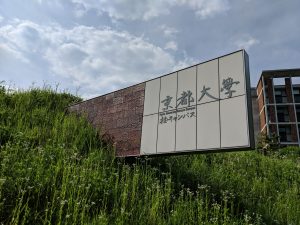
Kyoto University’s Katsura campus, where Prof. Kageyama’s lab is located, is set atop a large hill overlooking the town of Katsura as well as the surrounding landscape. When I first arrived, Daichi led me around the student office introducing me to the other students and vice versa. Everyone was pretty friendly, and though everyone spoke English fairly well, they were extremely impressed when they found out that I had studied Japanese in Atlanta! There is quite a bit of technical Japanese that I definitely don’t know yet, so I think the majority of my Japanese conversations will be limited to social situations.
My apartment in Omiya is fantastic, even if it’s a little on the small side. I fully expected to live in a smaller building, perhaps even with a roommate, and was ecstatic when I found out that I’d be in a studio apartment by myself! Back in the U.S., one of my favorite hobbies is cooking and baking, so I’ll have to make the most of the challenge that is my kitchen. I have a stovetop, microwave, and toaster, and I look forward to making some interesting foods this summer. My neighborhood has a lot of convenient features as well. There is a Family Mart right across the street from my front door, and there are two curry shops and a ramen shop within a block of my apartment. There is also a 24-hour grocery store with some very reasonable prices between my apartment and the Omiya Subway station. Each weekday morning, I take the subway two stops west to Katsura before transferring to a bus straight to campus – a quick and easy commute for sure!
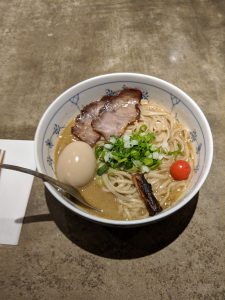
I’ve had a bit of free time in between and after lab sessions, and in that time, I have found a great many things to do in Kyoto. I have gone shopping quite a bit, in preparation for a few hiking expeditions this summer, and also have made time to go out for a few meals with my labmates and friends. I have also been practicing the shamisen that I bought in Tokyo, and have explored a bit more of my neighborhood. I still haven’t tried Kendo yet, but it’s next on my to-do list!
Reflections on Orientation Program in Tokyo
The orientation program in Tokyo was fun, and I’ll definitely miss the other Fellows – which’ll just make the mid-program meeting even more enjoyable! While certain activities like Taiko and the Mt. Fuji trip stick out more in my mind than others, I really appreciate having had the chance to get to know so many different aspects of Japanese culture in such a short three weeks. I learned a good amount of social etiquette that I certainly didn’t know about before coming to Japan, and I always like to make an effort to learn what’s considered polite and impolite in new cultures. Again, the core values of Harmony and Mindfulness come into play, reminding me that this is no new development and has always been an integral part of Japanese culture. I only wish this were more the case in America as well!
I am still quite curious about music in Japan, not only with regards to local variations, but also to performances and the evolution of Japanese music from very reserved and traditional pieces to the upbeat, bubbly pop songs that dominate Japanese music scene today. There is also a very distinct difference between Japanese Jazz and Western Jazz, and seeing as there is a jazz hall just around the corner from my apartment, I’d love to experience them for myself one night. I’ll have to check around Kyoto to see if there are any sort of musical museums that I could spend an afternoon visiting, or maybe find some bookshops that could shed some light on the whole story.
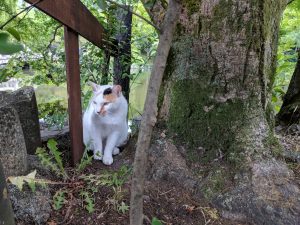
I also learned a good bit about myself since coming here. When I first arrive in a new city, I can be a very confident and incompetent navigator – a terrible combination when it comes to getting around. I believe I’ve managed to get lost at least once or twice a week since coming here, and couldn’t be happier about it! I firmly believe that when you get lost and stray off the beaten path, you almost always find something new and interesting, whether it be a hidden music store run out of a man’s home, a centuries-old knife forge, or a hole-in-the-wall basement ramen shop. Of course, over time I got my bearings and am now able to find my way around Kyoto’s major city centers with ease. Navigation problems were one of my greatest fears when first arriving here, and I’m proud to say that I have managed to cope very well since the first few days. In addition, I have confirmed something I long thought about myself but never really had a chance to try – I would be fine in a studio apartment. In the States, I have a bit of a bad habit of cluttering my room with things that I like, whether it be plants, posters, flags of sports teams, or an unnecessary number of instruments. However, the smaller space of my Kyoto studio apartment has forced me into a situation where I simply cannot overcrowd myself, lest I sleep under a pile of clothes and coats. In addition to all of the wonderful cultural experiences I’ve been lucky enough to have so far, I’ll definitely be able to use this summer as a lesson on interior design for my new apartment in Atlanta!
Introduction to Research Project
Similar to Emily Nishiwaki, the Nakatani Fellow who came to Prof. Kageyama’s lab last year, my research is based on improving a current process by innovating new materials and introducing them to a greater scientific audience. Currently, photocatalysts for the splitting of water into hydrogen and oxygen gas use ultraviolet-range (UV) radiation from the sun in order to excite electrons in the material and cause charge transfer, which can oxidize or reduce water into the target gasses. However, UV radiation only makes up about 4% of the sun’s total output, while visible light makes up about 40%. Therefore, finding a photocatalyst for this class of reactions that uses visible light rather than UV radiation could prove to be a massive step forward in the field of renewable energy, as it would essentially provide an energy-free way of producing clean hydrogen fuel.
I will proceed by mixing various ratios of TiO3 to ZrO3 to create a “solid solution” in PbO, which means that the crystal lattice of the material will have some Ti substituted in where Zr would usually be, or vice versa. It is worth noting that since these compounds contain a sizeable portion of lead, that this particular version is unlikely to go commercial. However, the proof-of-concept and introduction of viable visible-light photocatalysts is my goal, and the technology can be further improved from there. I create powders of these materials and then compress them into small pellets that I then can fire in a furnace to create my target materials. X-Ray Diffraction (XRD) technology is then used to check the purity and composition of the sample. I am fortunate enough to have used XRD technology before in my classes at Georgia Tech, so I was able to figure out the Kageyama Lab’s setup after just a little while of poking and prodding the software.
While I don’t have a concrete timeline for my research, I anticipate synthesizing three to seven possible ratios of powder every week and being able to check their photocatalytic activity about at the same rate. If I exhaust all meaningful ratios of the powders before mid-July, I plan on trying to synthesize other powders with entirely different elements that also seem to be promising photocatalysts. Of course, this is all subject to the mistakes I make and the problems we don’t anticipate along the way; something I’m already pretty familiar with. The shorthand name for my compounds are PZ, PT, and PZT, all of which sound fairly similar. This has led to one or two cases of me synthesizing a compound out of order, which didn’t necessarily ruin the experiment, but it was frustrating to start over since each powder takes about an hour to process from the reagent vial to the furnace. However, I have started writing down exact step-by-step instructions in my lab notebook and having Daichi check them over to make sure I’m preparing the proper experiment, and haven’t experienced any difficulties since starting this practice.
Question of the Week
Why don’t more people cook for themselves in Japan? It saves a great deal of money and even just having a rice cooker and a dozen eggs can save thousands of yen a month. Is it just considered inconvenient compared to the dozens of convenience stores and bakeries on every street block?
- This depends a great deal on generation/stage in life, just as it does in the U.S. too. While there are many people in Japan who love to cook, gender roles tend to be more fixed in Japan and typically it is the wife/mother who does all the cooking. However, most Japanese kitchens don’t have ovens so this is why you see so many bakeries. Breakfast is almost always eaten at home in Japan, typically centering around rice, and this is why in Japan you don’t typically see many breakfast restaurants or food stalls like you do in many other major cities in Asia. Almost everyone in Japan has a rice cooker (sometimes multiple) and most people wouldn’t consider making rice ‘cooking’ so much as something that is just part of the daily routine, to fill and set the timer on the rice cooker so you have hot rice for breakfast in the morning or after you come home. Preparing a lunch bento for your family is also typically a way of showing your love in Japan. For more on this, see the section on Bentos on our food in Japan page.
- Even if you live on your own in college, you also usually have access to an inexpensive on-campus cafeteria for lunch and sometimes dinner. Since kitchens in Japan, particularly fridges and cupboards, are so tiny, often you have to go to the grocery store daily to buy the ingredients you need for each meal you make. If you are a college student or work very long hours as an employee this may be inconvenient. Due to the long hours they need to study for the college entrance exam in high school, most teenagers spend most of their time at school, then may attend a cram school, and then may have to study or do homework long into the night. Therefore, they may not learn how to cook as their parents/mother would prefer to just cook for them so they can focus on their studies. So, though many college students in Japan may live on their own, that doesn’t necessarily mean they know how to cook.
- It’s also important to remember that eating out in Japan can be comparatively cheaper and healthier than in the U.S. In Japan, it is possible to find a high-quality, inexpensive lunch set for about 500¥ -800¥/~$5 – $8 and there are lots of other budget food options. In the U.S., the only way you can eat out for about $5 is usually to go to a fast-food restaurant. Eating out in Japan also tends to be healthier than in the U.S., where most restaurant food is heavily processed, high in fat/calories, and may contain a lot of salt. So, for health and budget reasons, it may be more common for people in the U.S. to cook meals on their own at home but even then, if you are in your 20s or early 30s a lot of disposable income in the U.S. is often spent on eating out. Often, it is not until people have children that they really begin to cook most meals consistently at home, but this varies a great deal by person/couple/family too.
- This might be an interesting question to talk to your Japanese friends in the lab or the Nakatani Japanese Fellows about. It might be interesting to ask them if they cook themselves and why or why not. I think you will find that while most young people in Japan may not cook a lot (or at all) you may also learn that a few of your Japanese friends share your own hobby/passion for cooking too.
Week 05: Cultural Analysis – Life in Japan
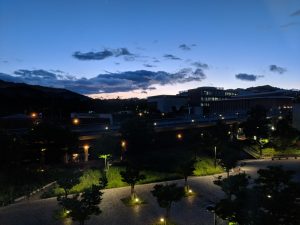
One of my favorite pastimes this summer has been cooking different foods and trying to recreate dishes I liked from restaurants that I have visited in Japan. One such dish I tried recreating was a cheese and pepper pasta dish called cacio e pepe that I’ve seen at a few different Japanese-Italian restaurants about town. I loaded my pockets with some change that I had (since you could just dump coins in the automated till at the store) and set off to get one or two ingredients that I didn’t yet have. At the store, I made my purchase, deposited my coins, and was hugely embarrassed when I was four yen short. I’ve dealt with this mistake in America before, and the general solution is to just put something back on the shelf and go at it again. However, I had no idea how to communicate this in Japanese- we had never planned for this situation in any of my classes!
I tried explaining myself to the clerk as the line of customers behind him slowly grew due to my own mistake, and I was feeling quite flustered when I heard a small *bing* from the till as an older man who was passing out of the store dropped a ten-yen coin into my till for me, smiling and nodding at my situation. Of course, I thanked the man profusely and apologized for the inconvenience to the other customers, who I’m sure just saw a student who misjudged his wallet, a common sight in any city with many colleges!
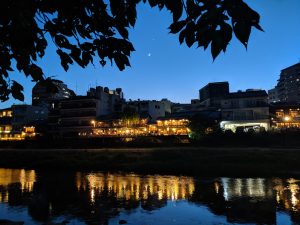
As I started the brief walk back to my apartment, I thought about this man’s kindness and how it fit into the attitudes of Japanese culture and relationships. While it’s very likely that this man just wanted to unclog this clot of people building up as a result of my mistake, I couldn’t help but remember the concept of harmony and the conscientious efficiency that runs through many aspects of Japanese life. Not only have I had a run-in with the Japanese sense of community and collaboration, but I’ve also learned to make sure that I’ve got a little extra in my pocket just in case!
Research Project Update
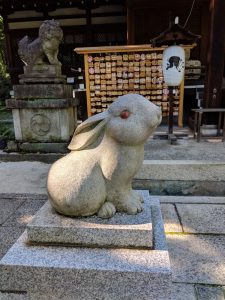
This week, Kato-san went off to Great Britain for a to present a poster at a conference, leaving me to proceed independently with only a bit of guidance via Line. I proceeded to synthesize various PbZrTiO3 (PZT) precursors, which I have checked for purity in the X-Ray Diffractometer (XRD). After last week’s difficulty with making a different compound than was planned, I made sure that I kept meticulous detail of each step of the process. There were a few days this week that I wanted to do more work but wasn’t sure how to proceed since Kato-san was a few thousand miles away, and the time difference didn’t help us. Because of this, I started designing a few experiments of my own (with the go-ahead from Kato-san) to boost the purity of my PbZrO3 reagents. The XRD scans that I accumulated last week showed a significant quantity of unreacted ZrO2 in the product, which I tried to rectify in a few different ways.
First, Kato-san and I dropped the reaction temperature by 100 degrees C, and when that helped a bit we also shortened the reaction time by a few hours. These modifications to the processing parameters of my PZT definitely showed some benefit in the product, but the best results came when I took the baked PZ, added in 10% by weight of PbO to help the rest of the ZrO2 react, then set it in the furnace for a few hours. This procedure yielded results almost identical to the theoretical simulations, which was a huge boost to my research and to my confidence as a researcher.
Next week, I will begin testing the photocatalytic activity of the PZT powders and attempt to find one that can reliably split water under visible light. While I have never done that test before, I will certainly have Kato-san back to help me along my way!
Question of the Week
I’ve seen quite a lot of hiking, rock climbing, and other outdoors sports-related shops in my time in Japan, especially in Kyoto. However, with so many people being so busy with their work and home lives all the time, when do people go to these establishments if not only on weekends? In addition, are winter sports such as Snowboarding popular in the later months?
- Mainichi ga nichiyoubi /Every day is Sunday: Keep in mind that there are a lot of retirees in Japan with lots of time on their hands and the disposable income to pursue some hobbies that they may not have had the time for previously. Most companies have mandatory retirement ages of 60, which is still quite young. So, whereas in the U.S. the ‘target market’ for sporting goods and outdoor companies tends to be people in the 20s – 40s, in Japan, these stores may be catering to a much wider range for their target market and many of their customers might be retirees. According to this blogger, one of the things that surprised them about hiking in Japan was that the predominant age range is 65+.
- Winter sports are also very popular in Japan, especially in places like Hokkaido that get a lot of snow. But, similar to the U.S., you might have to fly/travel to get to the ‘powder’ so unless you live in an area convenient to skiing/snowboarding it may be a yearly vacation rather than an everyday thing you do.
- For more, see the section on Sport, Outdoors, and Working out in Japan on our Life in Japan page.
Week 06: Cultural Analysis – In The Lab
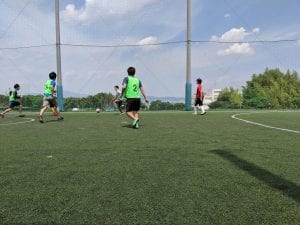
While I haven’t really experienced any cultural tension in the lab, I certainly have had a linguistic barrier to overcome. The main compound that I’m working with this summer is PbZr1-xTixO3, which is often shortened to PZT for simplicity. However, when x = 0 or 1, the compound is just referred to as PZ or PT, respectively. In addition, I often add excess Pb to my mixtures, since it is volatile and may go into the atmosphere before reacting with the other powders. To make things even worse, the co-catalyst I use for testing water-splitting is Platinum, which is abbreviated as Pt. The problem here is that there are a lot of very similar-sounding compounds, and since I’m testing the unique properties of each, it is very important to make sure that I use the proper one for a given test.
While I have done a lot of research independent from Kato-san and Prof. Kageyama, I occasionally get guidance from them regarding what I should synthesize or test next. This has lead to one or two occasions when I am told to make more PT, end up making PZ, and need to start over the next day! I started writing down my plans for the day and had Kato-san check them over visually to prevent any such confusion, but there was a short time when the x-values for PZ and PT were swapped, resulting in confusion even when written down! Kato-san and I took a short time to make sure that we both were on the same page regarding the x-values, then started using both written and verbal confirmation of my plan for the day, which has completely eliminated any chance of mistakes short of absentmindedness. Since I’ve become more and more independent, I have also not needed to check my plan with Kato-san as much lately since he trusts my judgement and the skills that he has taught me.
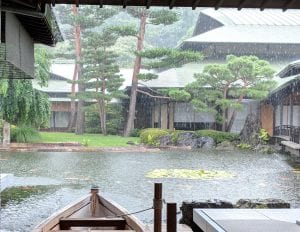
I have spent quite a bit of time in markets, grocery stores, and restaurants this summer. Of course, while may restaurants offer English-language menus alongside their Japanese variants to accommodate their tourist base, I always feel a little embarrassed when the staff has to reach into a separate drawer and pull out a large-type menu with more pictures and English text. In addition, when going to a new style of shop or using new services, there are many unwritten rules of how to act, and it’s certainly been a challenge solving these cultural riddles. However, in the past week or so, I have noticed this less and less. While ordering food and completing purchases are basic skills, they are integral to assimilation into a new country. I feel as though the first few weeks of trial-and-error conversations, guessing and correcting, and fumbling my way across the language barrier are really paying off, and I definitely feel accomplished as a result.
The only worry that really remains in my mind going into the mid-program meeting is the issue of what to do with my weekends. I want to make sure that I don’t just stay in my neighborhood every weekend, but I also don’t want to empty my bank account. I’ve taken to riding my bike around the city (The Kamogawa Riverside is my favorite route so far!) and finding some hiking trails to the east and north of Kyoto, but sometimes the more “tourist-y” attractions can eat away at my wallet without me realizing it. I’ve planned out a fairly thrifty weekend trip to Nara in a few weeks, and will be attending a Kyoto Sanga FC soccer game next month as well (the stadium is right on my commute from the lab to my apartment!). While the more famous attractions such as Kiyomizu-dera, Heian Jingu, and Fushimi-Inari are essentials of any Kyoto visit, I plan to get acquainted with more of the intimate side of Kyoto- without breaking the bank.
Research Project Update

I have really enjoyed my research project, particularly in the past week. While to date I’ve just been synthesizing and checking purity of my samples, I finally started measuring the photocatalytic activity of the powders this week! I had never done this process before, but I was sure that I could handle whatever equipment I was given. However, I’d be lying if I said that I was still fully confident when I first saw the jumbled maze of glass tubes, pumps, and dials that I’d be using. Though the equipment takes around four hours to set up start to finish, Kato-san was very helpful and showed me a few tricks I could use to make it a bit less tedious and cumbersome.
With the mid-program meeting coming up soon, I was a little worried about my pacing. I didn’t know how far along the other fellows were, and whether I was ahead, behind, or right where I needed to be. However, when I shared my current results with Prof. Kageyama, he reassured me that I was making good progress and that I’m moving along well. In order to make the most of my time in the lab, I have also reorganized the drawer that I use for storing all of my samples and notes. It was quite cluttered when I first arrived (I think Emily’s samples from last year were still in there!) but I’ve condensed the clutter and labelled all my powders in a way that lets me get what I need in a second or two instead of rooting through a basket for ten minutes.
I was also very happy to see that we implemented the idea of a co-catalyst in photocatalytic activity, since that was something I had read about on my own time and brought up to Kato-san and Prof. Kageyama. I really feel like this project is one of my own rather than just work that nobody else wanted! I’m very lucky to be in this lab surrounded by so many helpful people, and can’t wait to continue my work!
Question of the Week
What is the condition of the homeless population in Japan? I have seen very few people compared to New York and Atlanta, but also haven’t seen any shelters/help centers. Is there a more robust network for aiding in this situation in Japan, or is it just less common from the start?
- For more on this, see some of the articles under the Social Issues in Japan section of the Life in Japan resources page.
Week 07-08: Overview of Mid-Program Meeting & Research Host Lab Visit
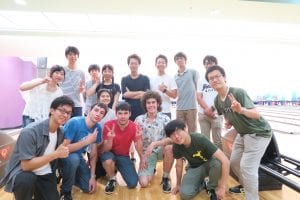
I had an absolute blast at the Mid-Program meeting. It was great to see all the other fellows again, and I loved showing everyone around Kyoto when we had time to spare. Before our intro dinner on Saturday, I went bowling with my lab. While everyone’s skill level was of course very different, it was surprisingly competitive! Kato-san would record everyone’s scored and re-balance the teams according to performance in an effort to keep it as fair and close as possible. Emily, a Nakatani Fellow from last year in the Kageyama lab, joined us for the games and also for the fellowship’s dinner that night. On Sunday we went and got yukata, then participated in a tea ceremony. Although I felt a little uncomfortable at first, (physically and otherwise,) I eventually warmed up to the yukata as we went through the day. The tea ceremony was interesting, as there is a complete focus on one action: just make some tea. While the actual steps in the process were very straightforward, we had to take great care in each action. This meant that concentration was key.
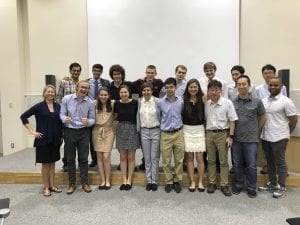
On Monday, each of the Fellows gave a brief summary of our work thus far, what it means to the world, and what results we’ve gathered. I really enjoyed hearing about everyone else’s projects and was very impressed with how well everyone could break down complex topics for people to understand in only a sentence or two. For example, I hadn’t the faintest idea what quantum computing entailed going into the presentations, but feel very comfortable discussing them after hearing a few presentations relating to the topic! I felt that I rushed myself a bit out of fear of running out of time, as I sometimes have a habit of over-explaining material. However, I think I did a fine job anyway. I am much, MUCH better at just conversing with someone and discussing research rather than presenting a scripted summary in front of an audience, so I’m definitely looking forward to the poster presentations in August!
We also had a tour of the Yoshida Campus at Kyodai as well as the iCeMS facilities just across the street. It was very interesting seeing a facility that so seamlessly integrated life sciences with physics and material sciences – I hope I can work in a place that has such rich interdisciplinary cooperation in the future.
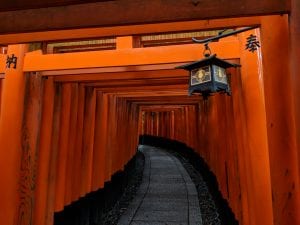
On the following day, I had a bit of a side trip. With the world cup being in Russia this year, the games were all scheduled at rather inopportune times for the Japanese audience. In fact, the Japan vs. Belgium game was at 3:00 AM on Tuesday. However, I was determined to go and watch it with a crowd – after all, I was in the best place in the world to cheer them on! After a late-night power nap, I headed to the Shijo district to find some friends, and unfortunately watched Japan lose in added time to Nacer Chadli’s late tap-in. Despite this letdown, I resolved to make the most of my morning – it was now 5:00 and I definitely was too excited to go back to sleep. I ended up biking to Fushimi-Inari Taisha, the head shrine of Inari Shinto, to have my own private walkabout. As it turns out, not too many people are up at 5:30 on a weekday. I was able to get some very special pictures of the Torii and other features of the shrine without hundreds and thousands of other tourists milling about, and even climbed Inariyama before heading back to the hotel! A brief sento later, I was ready for the day’s scheduled activities.
We first went to the Kamigamo-jinja shrine and saw the twin sanctuaries, which are a national treasure of Japan. Following that, we had a private tour of Shoukoku-ji temple and got to see some areas that are usually off-limits to regular tourists. I then went to the Kyoto National Art Museum and saw some truly beautiful works of art from tapestries and room-length wall scrolls to kimono and musical instruments. Satisfied with my activities for the day, I eventually returned home and had one of the best nights of sleep on the trip! This was definitely the best day of the mid-program meeting for me.
On the last day of the mid-program meeting, we went to Kobe to visit Sysmex, the medical sensor device company whose founder also established the Nakatani Foundation. I really appreciated the opportunity to visit a corporate lab with such an illustrious R & D department, as one of my goals for this fellowship was to get a bit of a better hold on whether I wanted to proceed in a research or industry direction. While medical sensing technology isn’t quite my area of interest, it is important to get a feel for the general lab culture and professional environment of a researcher. Before heading back to Kyoto, I wandered around Kobe for an hour or two, looking for some smaller, unique restaurants.
Easily the biggest problem I faced during the meeting was snapping back from a fairly lax, “come-in-sometime-before-ten” schedule to a rigid program itinerary. While I usually arrived at the hotel early, there was one day that I got stuck on my bus and nearly missed our private transportation from the hotel. However, with a bit of luck and a lot of running, I got there just in time. Flexibility is an important trait in any workplace or scholarly environment, so I will need to keep these transitions in mind as I continue my school life.
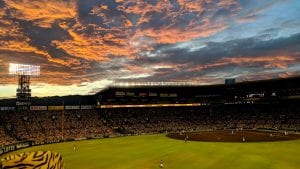
It was great seeing the 2018 Japanese Fellows again! I especially spent time with Katsuya, Mari, and Gen, though I also talked to Ryotaro and Yuki a far bit. As it turns out, Ryotaro is actually taking an online class from Georgia Tech this summer! The Kyoto U.S. fellows and I met up with Mari a week before the meeting for some okonomiyaki and general meandering around the city, so it was very easy to pick the conversation back up. The same can be said doubly so for Katsuya! He’s always so full of energy and loves telling and hearing some good stories, so he was very fun to hang out with during the week. He kept saying how my Yukata and haircut were a distinct blend of Western and Traditional cultures! I hope to meet up with Katsuya again before heading back to America, or maybe to make a trip to Houston in September to see the Fellows’ presentations if I have the time!
Research Project Update
I’ve had a very important breakthrough in my project from the last report to now- I have finally found a reliable method for synthesizing bulk amounts of PZ powder! I need this powder to act as an atmospheric lead supplier in the second-step reaction of PZT photocatalysts, and any impurities in the atmosphere can actually enter the PZT reaction and contaminate the final sample. However, by changing a few processing parameters, Kato-san and I have figured out a reliable, repeatable way to achieve this synthesis. My goals for this week are making second-step powders for each of my nine target PZT compositions, and then analyzing as many of them as possible in the Photocatalytic activity test. Here’s hoping everything goes as planned!
Photos
Week 09: Research in Japan vs. Research in the U.S.
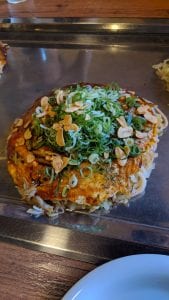
I am fortunate enough to have been able to do research in a lab at Georgia Tech for the past two years before beginning the Nakatani Fellowship. I worked part-time in a small Materials Science lab under Professor Rosario Gerhardt, manufacturing and analyzing thin films of Indium Tin Oxide. The Gerhardt Group is fairly small, with four graduate students, five undergraduates, and Professor Gerhardt herself making up the entirely of the group. Of course, there are many other labs in our department, as well as the country at large, that are much larger. For example, Professor Seung Soon Jang has over thirty undergraduate and graduate students in his group, a similar size to the Kageyama Lab at Kyoto University. Aside from the glaring size contrast, there are a few other differences that have caught my eye in the past month and a half.
The most obvious change I’ve experienced is the upgrade from a part-time, “hours-as-you-please” research schedule to a much more concrete structure. I would try and fit in experiments and measurements in between classes or whenever I could find the time on weekends at Georgia Tech, but at Kyoto University I have a much more intense, committed schedule that sees me in the lab an average of 46-50 hours a week. I definitely get a much better sense of progress in this schedule and will likely be able to step up my research commitment at Georgia Tech next semester, following the refinement of my skills here at Kyodai.
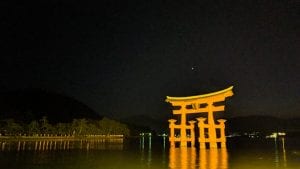
Another reason for this expanded sense of accomplishment is due to the equipment available to me at Kyodai versus at Georgia Tech. Due to a fundamental difference in the way that funding is allocated in Japan and America, lab equipment is much more sophisticated in Japan, and each lab usually has their own personal setups rather than sharing with other research groups. Compare that to my home lab, where the spin coating machine I use was pulled from the surplus of another MSE lab, and the difference between American and Japanese research groups is even more apparent.
I also had some expectations of the people in my group when I first came to Kyodai, and it has been very interesting to see them confirmed or shattered. For instance, the first few weeks I made sure to wake up every morning at 7:30, get to lab at 8:50, and make a good impression. However, often times students won’t filter in until about 10 or 11 in the morning, which honestly is much more my speed. They generally compensate by staying long into the night, with many students performing experiments until 9 or even 10 in the evening! Many students work very hard and spend extreme amounts of time in the lab. As I write this, I can see three students power-napping, as well as another with a bottle of shampoo on his desk. I guess it’s better than the alternative.
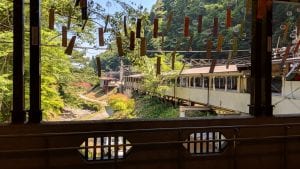
Every month, the Kageyama laboratory has a presentation meeting called a “Kenso,” which means “observations” in Japanese. At a Kenso, every member of the group presents their past month’s work. Since it is one of the few times that Prof. Kageyama is able to directly hear updates and discussion from his students, everyone makes sure to put in a LOT of work to their presentations. I’ve seen multiple people typing away at their laptops the night before a Kenso, squeezing in as much important detail into the presentation as they can. However, these meetings tend to run long- the June Kenso on my first Friday at Kyodai went from ten in the morning to nearly nine at night! Despite their length, Kenso are an invaluable learning tool that promotes cross-disciplinary research and mutual criticism at large. In my home group, we have much shorter weekly meetings with the group with one or perhaps two presentations as well as one-on-one with professor Gerhardt.
Research Project Update
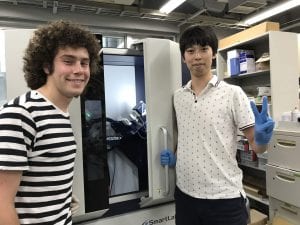
As I stated in my last report, I have finally found a route for reliably and easily producing high-purity PZ powder for second-step refinement of PZT Photocatalysts. Since I’ve now confirmed that this method is reproducible, I have moved forward in manufacturing the full range of compositions of second-step PZT photocatalysts. I have all nine first-step powders complete and represented, and at this time have synthesized 5 of the 9 second-step powders. All that remains is to measure the photocatalytic activity of these nine powders and verify that the powders are not destroyed during the process.
I plan on making these verifications via a comparison of the X-Ray Diffraction pattern of the same powder before and after it reacts, as well as a topographical analysis of the photocatalyst via a scanning electron microscope. Should I finish this project early, and it seems as though I just might, I will partner more closely with Kato-san in synthesizing brand-new oxynitride materials that have never been made before. There’s always more to be done!
Question of the Week
What sort of differences are there regarding patriotism in Japan? I know in America, we often take it to heights not seen in most countries around the globe, But I’ve only seen a Japanese flag at sporting events or flown on buildings.
- Yes, it is true that, compared to most countries in the world, America takes our display of flags as a sign of patriotism to extremes that many other countries would find offensive, weird, or down right disrespectful. With the possible exception of the United Kingdom’s ‘Union Jack’, it is rare for people to use the nation’s flag a symbol to sell merchandise, on clothing, on throw away items like paper plates, etc. In some countries, doing so could even be illegal. In most countries displays of the flag are closer to what you have observed in Japan. Flags are flown at government buildings, schools, and at sporting events/jerseys; but flags are not used as a mass-market, consumer-driven display. Indeed, many of the uses of the American flag in the U.S. today are actually in violation of our 1923 flag code too…
- Why Do American’s Love their Flag (BBC YouTube Video)
- Flying the Flag: American Style (BBC)
- Birth of America’s Flag Obsession (Time)
- American’s Flag Obsession is Not Exception (Time)
- Why Are American’s So Crazy About their Flag (How Stuff Works)
- How Americans are Perceived by the Rest of the World (CBS News)
- Foreigners Share What They Can’t Believe about America (Business Insider)
- History matters here too. Consider that Japan, as a country and culture, has existed since 500 AD compared to the U.S. which was only established in 1776. Japan has a much longer history and more cultural/national icons and symbols to draw on than the U.S. Also, as a homogenous nation, Japan does not need a flag to be used as a visual representation of what it means to be an ‘American’ or the unity of our nation in a heterogenous society like the U.S. The American flag therefore serves as a unifying symbol in a way that the Japanese flag does not have to. After all, the the Pledge of Allegiance to the Flag that most schoolchildren in the U.S. recite each morning states: “I pledge allegiance to the Flag of the United States of America, and to the Republic for which it stands, one nation, under god, indivisible, with liberty and justice for all”. The flag is not only a visual representation of our national ideals, but also serves to unite and inculcate disparate groups in the U.S. under the ideal of what it means to be an American.
- That is not to say that the Japanese flag does not have an important historical role. While today you primarily see the Japanese flag displayed on government buildings, schools, and at sporting event it does still embody a sense of patriotism and unity for people in Japan. However, overt displays of the flag for patriotic, political, or commercial uses in Japan are generally frowned upon for the connections they would have to Japan’s period of colonialism and militarism during the era of the ‘Greater East Asian Co-Prosperity Sphere’ which led to the forcible invasion of many Asian nations. However, there are movements in Japan to re-new national identity and patriotism through expanded use/display of the flag though this is still controversial due to its perceived connection with Japan’s imperialistic and militaristic past.
- Why Do Flags Matter? The Case of Japan (The Conversation)
- Meaning and History of the Japanese Flag (Japan Info)
- National Flag and Citizens’ Views Towards their Country in Japan
- 5 Fun Facts About the Flag of Japan (Sora News)
- Tokyo’s Flag Law: Proud Patriotism or Indoctrination (NY Times)
- Japan’s Rising Right-Wing Nationalism (Vox)
- Abe’s Perilous Patriotism: Why Japan’s New Nationalism Still Creates Problems for the Region and U.S.-Japan Alliance (CSIS)
- Japanese Kindergarten Teaches Student’s Pre-War Ideals (Reuters)
- Patriotism, Nationalism, and Internationalism Among Japanese Citizens (2002, Journal of Political Psychology)
Week 10: Reflections on Japanese Language Learning

Probably the most important preparation a person can do before going to a foreign country is learning the native language, or at least some key phrases. I had studied Japanese language and culture for about two years prior to participating in the Nakatani RIES Fellowship. I started taking official classes my second semester at Georgia Tech, after consulting a friend who was graduating who had double-majored in Japanese and Computer Science. I had long had an interest in Japanese language and culture due to a great many interactions with a Japanese man who ran a small sushi shop in my hometown, and learning the language seemed like a great first step to learning more and more about Japan’s culture and history as well. I really enjoyed the classes at Tech – the teachers were native speakers who are very passionate about sharing their knowledge, and although the workload was very intense compared to other language classes I’ve taken, I definitely learned a great deal.
One of the major draws of the Nakatani Program is the opportunity to put my language skills in use in Japan itself, rather than just in a sterile classroom environment. In addition to having the chance to put my previous knowledge into practice, I also had three weeks of Japanese language instruction upon arrival in Tokyo. While I didn’t feel like I learned anything new from the lessons, it was still good practice and review. Although I definitely use my Japanese language skills in daily life, I tend to keep them out of the lab environment. Maintaining proper procedures, practices, and communication is very important to me with regards to lab work, and as such I am hesitant to try and practice Japanese during research- there is simply too much room for being wrong and setting myself back in the limited time I have available in lab.
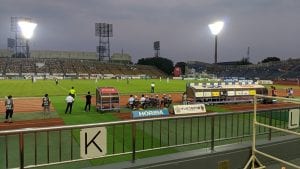
Instead, I try and use my Japanese in day-to-day life throughout the summer, whether that be at the supermarket, restaurants, interacting with transport faculty, or talking with friends outside of lab. Since Kato-san and I both really like playing soccer, we’ve gone and played Futsal, five-a-side soccer played on a smaller field, a few times after working at the lab. In fact, there’s a lab-vs-lab tournament this upcoming Monday that we can’t wait for! The Katsura campus has a long history of lab-vs-lab athletic competitions, and the futsal tournament is no exception. There is even an ornate trophy with a long history of every winner at stake! I am used to being very vocal while playing, as I have played soccer since I was about five years old and at least like to think that I have a pretty good understanding of the game and how to play it. However, it is very difficult to call out instructions or warnings to teammates when you don’t know any sports-related terminology! This problem was even worse for me since I had studied Spanish for about seven or eight years through grade school. As I went to call out “Two men on you!” or “Pass it to Ishihara!” I would think “Oh right, don’t use English, nobody’ll understand” and promptly starting babbling strategy in Spanish instead! As we played more and more, I would exchange soccer jargon with the other players, and I learned a few new phrases. A lot of Japanese-English words are just two or more English words crammed together and shortened (“Nice [goal]Keeper!” becomes “Nike!), which certainly made it easier for me to grasp. Having mainly watched the English Premier League growing up, I instinctively default to a lot of British English phrases when talking about soccer, for instance calling a “good cross” a “nice ball in,” which also seemed to amuse the Japanese students I played with – they even started using some of them themselves!
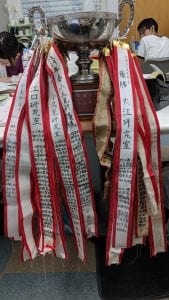
As a brief side note, I have always been a fan of sports teams that aren’t known for winning every possible trophy year in and year out. After all, if the same team wins every year, it isn’t as special, and I’d feel like I’m jumping onto a bandwagon rather than picking a team that I felt attached to. So, when I found out about Kyoto Sanga, currently placed 22nd out of 22 teams in the second-tier of Japan’s national J-League, I was instantly in love. The fan atmosphere was incredible – after all, you’ve gotta be truly dedicated if you’re going to support a team with those stats. Plus, the stadium is a 15-minute, 200-yen trip from my front door, and the best seats in the place cost less than any top-tier team in the country! Since I collect soccer jerseys too, their design was a big attraction for me – purple, black and red with unique geometric striping and silver trim is a far cry from the cookie-cutter templates that Nike has pumped out for the last few years. There is another home game on the last Sunday before I return to Tokyo, and I certainly hope to make it out!
Although I had already started pursuing a minor in Japanese language prior to my application to the Nakatani RIES Fellowship, this program has definitely helped to solidify my passion for the language, culture, and people of this country. I look forward to taking more technical-leaning language classes at Tech in the future, and I hope to return to Japan for further research or other studies. Of course, I wouldn’t be against a vacation or pure sightseeing trip either!
I firmly believe that the best way to learn a language is by speaking and listening to native speakers in as immersive an environment as possible. Whether it be going out to a restaurant, doing research in a lab, or just knocking a ball around with some new friends, actual people will always be better teachers than pure reading from a textbook.
Research Project Update
Ever since finding the best procedure for synthesizing the necessary atmosphere powder a few weeks ago, I have been in a bit of a mad rush to synthesize as many samples as possible in the time I have left. Since my research hinges on analyzing a full range of high-purity samples, the discovery of a higher-purity method meant restarting each of my finished samples from the halfway point. I also had to wait for a shipment of more lead oxide to arrive, as my understanding of what size was reasonable for each sample was much larger than necessary. Nevertheless, I have synthesized all of the necessary samples save for one, which I will make in the interim period of testing out the other powders’ photocatalytic activity.
Speaking of which, I have almost completely mastered the process of measuring photocatalytic activity. What started out as a daunting task fraught with unfamiliar kanji and blind navigation of an all-Japanese console has become just another lab task, and I have even written out a detailed guide on the process, from start to finish, to aid any future students in the Kageyama lab. Kato-san will be out of the country again next week for a conference, so I will have a perfect chance to put my skills and guide to the test in quite the trial-by-fire situation. Each of these tests takes a day to complete, and I have just two days to spare between my last day at the lab and the last sample being finished testing, if I work at full efficiency. I’m not too worried though, as I’ve already learned plenty during my time here and am confident that I could have a great conversation with anyone who is interested in my poster!
On Friday, Kato-san began teaching me how to make certain Oxy-Nitride compounds in an effort to maximize the breadth of my learning while in Kyoto. Though I don’t know a whole lot about this separate project yet, I am excited to be learning even more, and definitely appreciate having a second project to fill in the times when I’m sat around waiting for tests or syntheses to finish!
Question of the Week
Japan is a country that celebrates and relaxes with just as much intensity as it works. Festivals, parties, and even friendly lab-vs-lab tournaments have a distinctly Japanese organization to them, but is it ever too intense for some people? Does the constant planning and “Organized Fun” ever get to be too structured?
Week 11: Interview with Japanese Researcher
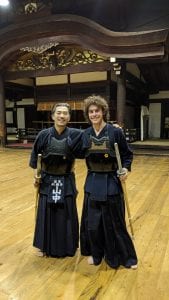
This week, I had the opportunity to talk one-on-one with some of the researchers in my lab for a brief interview regarding their research experience. I spoke with Thibault Broux, a French post-doctoral researcher, and Xia Jingxin (Nacchan), a Chinese B4 student. I chose these two researchers because I thought that their experiences as a foreigner living in Japan while doing research would be very beneficial to me, as I find myself in the same situation! I also thought it’d be a good idea to get views from either end of the spectrum as far as time in the field went. I found that Thibault and Nacchan had some fairly different views overall.
Thibault has travelled to a great many labs in different countries and has been at the Kageyama Lab for about eight months now. He entered Materials Science to explore solid-state chemistry in energy technology, and earned a Ph. D to that effect. He said that he expected to go abroad for research as he progressed through his own university life, though he didn’t expect to go to Japan! However, he says that since labs everywhere are very internationalized, the experience isn’t too far off from his past experience in French labs. However, casual conversation has been a bit of a roadblock, something he has overcome by finding a network of French people throughout Kyoto. When asked how the experience of moving around so much affected him and his wife, he looked to the positive side of relocating, saying that it is like a holiday, with so many different people and places to see!
Finally, I asked Thibault about a couple of hypothetical situations. I was curious about how different people value lab priorities, so I asked him what he would do differently or value if he ran his own research group. Reflecting my own values, Thibault said that he would place an emphasis on collaboration between other labs. However, when I asked Thibault what advice he would give himself in freshman year of undergraduate schooling, he warned against searching out permanent, locked-down positions, citing the importance of politics, luck, and other factors that we never have full control over. He advised against that route, and rather recommended the more mobile lifestyle that he has enjoyed – which I must say has caught my attention a great deal!
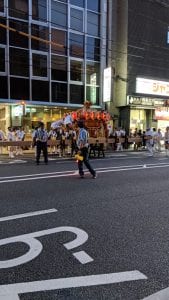
Next, I asked Nacchan some questions about her experience in the Kageyama laboratory. She is currently pursuing a Chemistry degree since it was her favorite subject in High School and Kyoto University has a great Chemistry program. She decided to come to Japan to study at university in her freshman year of high school, and worked hard to achieve her goal. I asked her what her experience was like studying in a foreign country, since that is a very relatable field for me. Nacchan said that although she does sometimes feel lonely and homesick, there are so many good things that happen and so many nice people around that it ends up being a positive experience at large. I completely agree with this sentiment for the same reasons!
Similar to the interview with Thibault, I then asked what she would value in her own research group. In contrast to Thubault’s answer, Nacchan emphasized originality and innovation, a certainly admirable mindset that I subscribe to as well! Finally, Nacchan gave herself some advice in the past – study harder and build the best foundation for future studies as possible. This is extremely important in so many different fields, as fundamentals of any science, discipline, and activities all rely on a few core principles that are then expanded to new heights.
Reflections on the Interviews
I really appreciated Thibault and Nacchan taking the time out of their busy lives to provide me with new perspectives on research. It is often said that hindsight is 20/20, so having the benefit of someone else’s experience to shape your own vision is a real asset! I didn’t understand what post-docs did before meeting Thibault, and hope to be in a similar situation as him in the future, since he definitely seems to be enjoying his research life and balances it well with time outside of the lab too. Nacchan provided me with a bit more reassuring words in that homesickness and the occasional bout of loneliness is to be expected, and is mitigated by the people you surround yourself with. Overall, these interviews definitely helped me to understand what my future in research could look like, and I’m a bit relieved to see that there is the opportunity for such a great work-travel symbiosis as Thibault has experienced. I’ll make sure that I really buckle down and get the best foundation possible for my future!
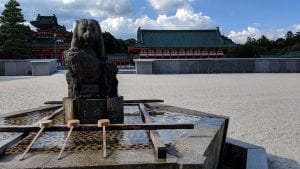
Question of the Week
Many students in my lab have gone abroad this summer for research presentations, despite Japan being renowned worldwide for being at the forefront of Materials Science Research. Is there a greater appeal to European presentations because of the great variety in nations there, or is it just a coincidence that so many conferences seem to be help in Europe?
- A key factor in which conferences a lab sends students/researchers to attend is who will be there. First, they look for conferences or meetings where they know many of their key collaborators or potential collaborators in their field may be. During the conference itself they may plan to meet with their collaborators to discuss their research projects.
- Next, a consideration would likely be the the diversity of people/researchers that are likely to attend. For a conference in Europe, attendees are drawn from throughout the region and presentations are almost always in English. This leads to a much wider number/array of potential attendees than a domestic conference in Japan where research may primarily be presented in Japanese (limited who can attend). Attending conferences conducted in English, also gives Japanese students an opportunity to hone their English research presentation and professional communication skills.
- Finally, it is important to remember that the presentation of your research at a conference typically takes up just one or two hours out of a 3 – 5 day event. The rest of that time is spent networking with collaborators or potential collaborators in your field and learning about what is coming up next in new and emerging research areas and topics. This relates back to the first point, that who will be attending the conference is usually the most important consideration when choose which conferences to attend and who to send. Conferences can also be great places to do informational interviews (similar to what you did for this week’s report) to learn more about different research fields/topics, career paths, or potential graduate schools you may be interested in. For more on networking at conferences see:
- Two PhDs Go to a Conference, One Gets Hired (Cheeky Scientist)
- How to Network Effectively (Science)
- 10 Tips for Easier Networking at Scientific Conferences (Medium)
- Networking Tips for Graduate Students (Nature)
- Leveraging the Untapped Power of Informational Interviews (SPS)
- Conducting Informational Interviews (Idealist)
Research Project Update
I don’t have much to say about my research project that’s new from last week. I have continued running photocatalytic tests and have also been working on my poster and final Kenso, as well as the Nakatani Presentation for next week in Tokyo! As I wind down my last week in the lab, I find myself disappointedly looking at plots showing no apparent correlation of the factors I have been testing for, though this development may simply mean that there are other venues to explore in its place. Regardless, I have a few more tests to run this week so Kato-san and I will refrain from making any hard conclusions until we have all of the facts!
Week 12-13: Final Week at Research Lab & Re-Entry Program
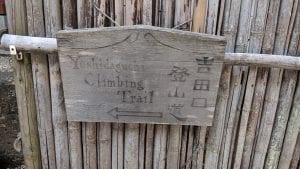
My last few weeks in lab were a bit of a sprint towards a finally clear goal. I had nine samples to test, and each test took a minimum of one full day to run, so I had to make sure that absolutely everything ran exactly perfectly in order to get all of my desired testing completed before leaving Kyoto. Unfortunately, real life rarely goes according to plan, and I was met with gas leaks, equipment unavailability, and my own errors in a cocktail of setbacks that left me with only five of my nine samples fully analyzed. However, in this analysis I did find an exciting trend between the parameters I was analyzing, which means that this project will definitely be continued past my time at Kyoto University. To that end, since returning to the U.S. I’ve been messaging back and forth with Kato-san, Kakito-san, and others in my lab to continue our friendships and discuss everyday goings-on in our lives.
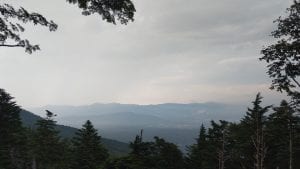
My last weekend in Japan was an absolute flurry of activity, and I am still bewildered by how much was packed into a few days. On Friday, I had my last Kenso presentation of the summer with my lab, and we went out for dinner afterwards at a yakitori restaurant. It was a bittersweet night, but we had a lot of fun. When I got my sashimi plate, Shou-san told me jokingly that the wasabi was “Delicious matcha ice-cream!” and that I should eat it by itself – I played along for the bit and got a good rise out of everyone when I downed it, earning myself an actual dessert from my table in the process! As I finally headed home on the train, I stopped off at a Family Mart to ship my luggage off to Tokyo, then got to bed for an early morning trip to a familiar shrine.
On Saturday, I woke up at five, and headed for Kyoto Station. I caught a shinkansen to Mishima, then took a bus to Kitaguchi-Fuji-Hongu Sengen Jinja, where we visited back in week two for the Mt. Fuji lakes trip. This shrine is the trailhead for the Yoshida trail, which is the most popular route of ascent up Mt. Fuji. However, most people tend to start
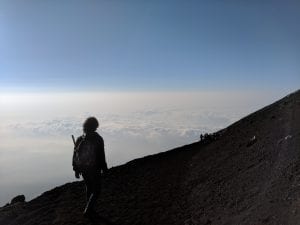
their hike at the fifth station by taking a bus from Shinjuku bus terminal in Tokyo. By starting at the shrine, I added about 20 km to my hike, but was rewarded with some pretty amazing views of the mountain valley on the way up. In addition, I only saw about a dozen people on my way up, a stark contrast to the absolute mosh pit that is the top half of the Mt. Fuji trail. While this first 20 km only took me about 5 hours, the final 7 km from the fifth station to the summit took our group about 7 hours due to the crowds. Despite the hundreds and hundreds of other tourists shuffling up the slopes with us, we managed to find a corner of the volcanic crater that was fairly separated from the bigger crowds, and viewed the sunrise through a partly cloudy but unobstructed sky. After a somewhat monotonous descent, I got lunch at the fifth station then used my Japanese language experience from the summer to negotiate myself onto an earlier bus back to Tokyo.
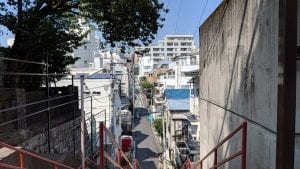
During the few days we had in Tokyo, I had a few last goals before heading back off to Houston. First, as I was returning to the Sanuki Club from Mt. Fuji, I stopped off at the Suga Shrine in Shinjuku to fill in the fiftieth page of my Goshuinmon, completing a months-long goal of visiting some of the many shrines across Japan. That evening, I took the other U.S. fellows to my favorite ramen shop that I’ve been to (from week two’s report!) and it was so good that we went back the next afternoon for lunch! When we finally gave our last presentations and headed to Narita International airport, I was certainly sad to be leaving, but content in the fact that I’d had such an incredible time and have so many ways to remember it by!
Final Question of the Week
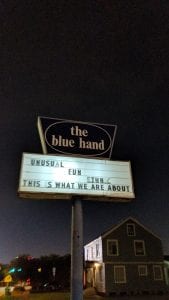
How many people in Japan end up working outside of the country for their careers? Do most people work domestically or is there a culture of “exporting workers?”
- Most large Japanese companies have overseas offices or subsidiaries and, as you rise up the career ladder, they regularly send Japanese managers and employees for overseas placements. These are typically about 1 – 3 years in length but, overall, this is a very small number of Japanese living and working overseas. Indeed, much like in the U.S., the vast majority of Japanese workers have no desire or interest in living or working abroad. People in America and in Japan tend to like/prefer ‘being at home’ and are not, generally, as geographically mobile as Europeans and Asians for example. This trend can also be seen in the global mobility of scientists and researchers as well where the U.S. and Japan are least liking to have their researchers living abroad.
- Global Mobility: Science on the Move (Nature)
- Japan’s Workers: Please Don’t Send Me Abroad (WSJ)
- Why Do So Few Young Japanese Want to Work Overseas? (Japan Today)
- Counting the Uncountable: Overseas Americans
- Five Reasons Why Americans Often Don’t Leave America (Psychology Today)
Final Research Project Overview & Poster
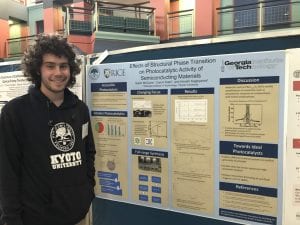
I had a good time in Tokyo on the day of our final presentation, as I felt that the atmosphere was more relaxed than I had anticipated. I much prefer poster sessions to scripted presentations, since I’m more comfortable having a conversation with someone rather than just talking “at” them with a rehearsed script, but the nature and general feel of the room at the final Tokyo presentations made me feel more at ease and I had plenty of time to say what I wanted to. Unfortunately, I got just a bit too comfortable, since I ended up running a bit over time. Usually, I have a bad habit of peeking at the timer then rushing through my presentation to make sure I don’t go too far over time, but the lighthearted atmosphere made me feel a bit too lax, so I could definitely improve in that area. Composure in all presentations and competitions is extremely important!
The Smalley-Curl Institute Summer Research Colloquium poster presentations were another highlight of my last few days with the Nakatani Fellowship as I love poster presentations and had a wonderful time with everyone who came up to view my work – not just the judges! I still felt very at ease and comfortable despite it being such a hectic environment, which I chalk up to the fact that I was right next to some great friends for the whole time! There were also a lot of fantastic graduate presentations I attended, but my favorite was definitely early on in the day, when one speaker presented her work on electrically-controlled deformation of a certain material. She described this material as “non-sentient Flubber,” though as a fan of the film I’ve gotta admit I’m looking forward to the next version with a much better sense of humor than the current material.
Research Abstract and Poster: The Effects of Structural Phase Transition on Photocatalytic Activity (PDF)
Host Lab in Japan: Kyoto University – Dept. of Energy & Hydrocarbon Chemistry, Kageyama Laboratory
Host Professor: Prof. Hiroshi Kageyama
This summer, I worked in Professor Hiroshi Kageyama’s lab under Daichi Kato at the Katsura campus of Kyoto University. The goal of my project, “The Effects of Structural Phase Transition on Photocatalytic Activity,” was to devise a new strategy for improving the Apparent Quantum Efficiency of semiconductor photocatalysts. We approached this problem not from the established surface-level (literally) analysis, but rather from the interactions of the different crystal structures present in perovskites- particularly where they mix. We found, through gas production analysis and SEM microscopy, that the synthesized powders exhibited amplified production ability at the phase boundary. This is very exciting, because if this strategy is verified to continue to other samples rather than being a one-off deal, then this work could be used to find the next generation of photocatalysts for energy and chemical synthesis technologies!
Follow-on Project
My school has a “Japan Study abroad day,” I’ll be giving a presentation on my Nakatani Experience there to students interested in the program.
Tips for Future Participants
- Studying basic kanji, like store signs, your local neighborhoods, and station navigation is just as important as speaking practice. Writing isn’t emphasized as much, though if you plan on coming back, it’s always helpful to know more!
- Make sure you don’t overpack! You don’t need a whole lot, and if you bring an empty suitcase to fill with souvenirs and gifts, you’ll have a much easier time traveling!
- As tempting as it can be to bring chocolate as omiyage, try to bring something specific to you! A fridge magnet, t-shirt, or mug from your school or hometown is much more meaningful, though some non-meltable snacks are always appreciated!
- Make sure you have some sort of plan every week. Even if it’s some basic goal like “find a sushi shop” or “go for a walk,” it’s important to make sure that you get out of the house and experience Japan!
